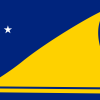Tuvalu Travel Guide
Welcome to the taste2travel Tuvalu Travel Guide!
Date Visited: January 2018
Introduction
Located well off any tourist trail – Tuvalu is a collection of nine picturesque, coral atolls, which is home to a population of 11,000 friendly, welcoming souls. The country is the third-least populous sovereign state in the world, the world’s least visited country and (at just 26 square kilometres or 10 square miles) the fourth smallest country in the world.

A view of the Pacific Ocean from Funafuti, with a drop-off very close to shore.
Unlike Fiji – it’s tourist-savvy neighbour 1,000-km to the south – Tuvalu is well off the tourist radar – it’s the destination that tourism forgot. According to a report by the United Nations World Tourism Organisation (UNWTO), Tuvalu was the least visited place on the planet in 2016, welcoming just 2,000 arrivals over twelve months – despite being a tropical paradise.
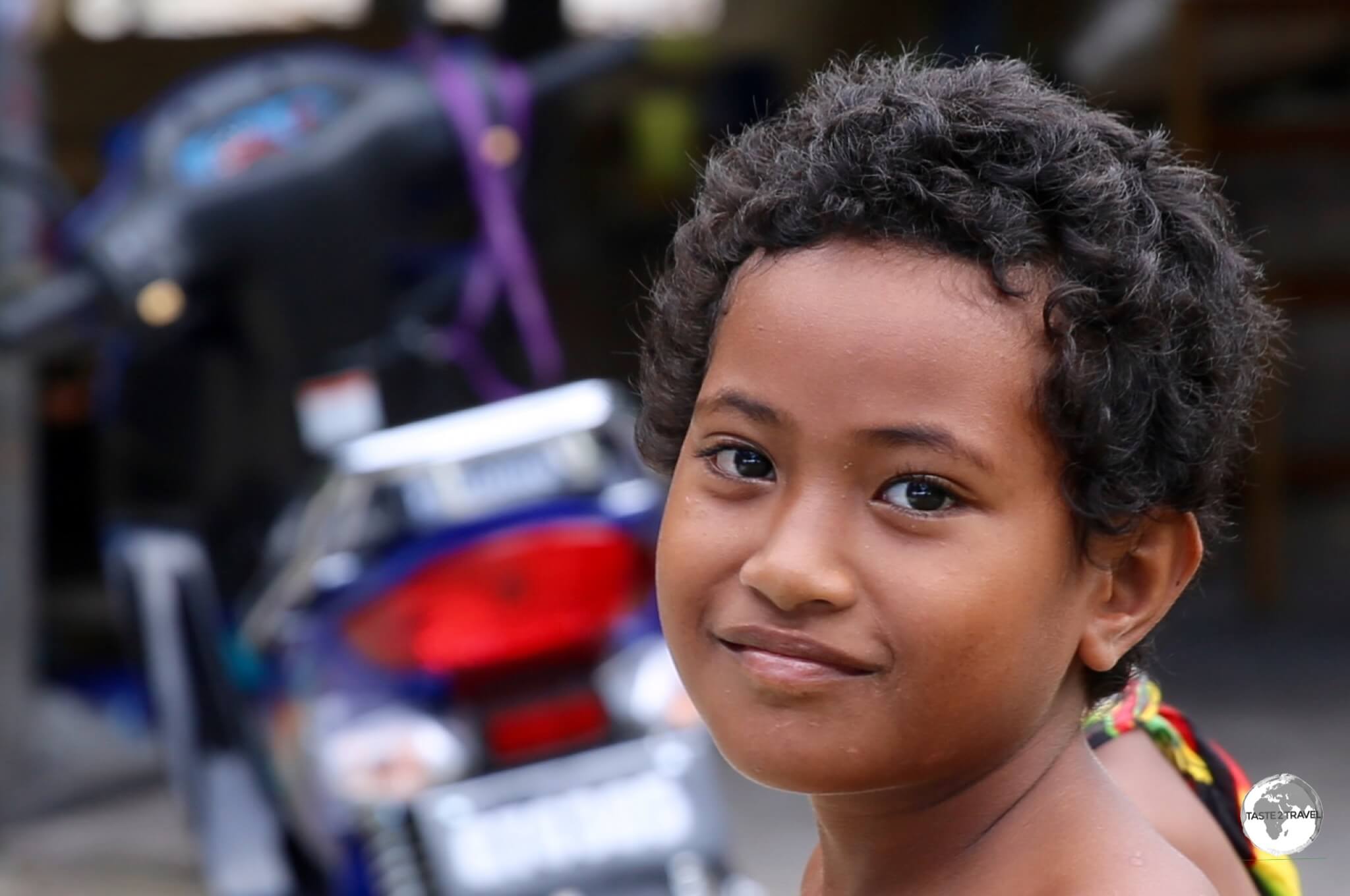
The Tuvaluan’s are very friendly and welcoming.
A former British colony known as the Ellice Islands, just three flights a week connect Tuvalu with the outside world (see the ‘Getting There’ section below). About 50% of arrivals are on business (mostly aid/ NGO workers) and almost everyone else is an overseas Tuvaluan returning home to visit family/ friends.
Very few tourists make it to this remote corner of the Pacific (I didn’t meet any during my 7 days there) and those few who do make the journey will find they’ll have this tiny nation to themselves.

A white Tern battling the sea breeze on Funafuti.
Once there, you’ll find there are no sights to explore, no museums or galleries to visit, no souvenir shops to peruse, no tour guides, no island tours or anything else you might expect from a regular destination.
There’s nothing ‘regular’ about Tuvalu and that’s part of its charm. What it lacks in sights, it makes up for in beautiful nature. The turquoise waters of Funafuti lagoon are stunning.

All homes on Funafuti have sea frontage and most have a hammock or two overlooking the lagoon.
There are no ATM’s in the country and Credit Cards are not accepted anywhere, so you’ll need to bring enough cash (Australian dollars) with you for your entire trip. Internet signal is almost non-existent, thereby ensuring you’ll be off-the-grid most of the time.
Accommodation options include one (basic) hotel and a number of basic family-run lodges. There are no cafe’s and no decent coffee to be found anywhere, however there are a few restaurants, serving simple, affordable meals.

“Tuvalu Blues” – a view of Funafuti lagoon.
Tuvalu is not a destination for everyone – but – if you’re an adventurous soul looking to travel somewhere that’s well off the beaten track, where a guidebook or an itinerary are not necessary then Tuvalu awaits.
Location
Vaiaku, Tuvalu
Tuvalu is located seven degrees south of the Equator, 1000-km north of Fiji, in the Central Pacific. Lying approximately halfway between Hawaii and Australia, its nearest neighbours are Kiribati, Nauru, Samoa and Fiji.
The main island of Funafuti is a long, thin sliver of land with a calm ‘lagoon’ side and a rough and exposed ‘ocean’ side. All activity on the island is focused on the lagoon side with the one main road following its shoreline and all houses fronting the lagoon.
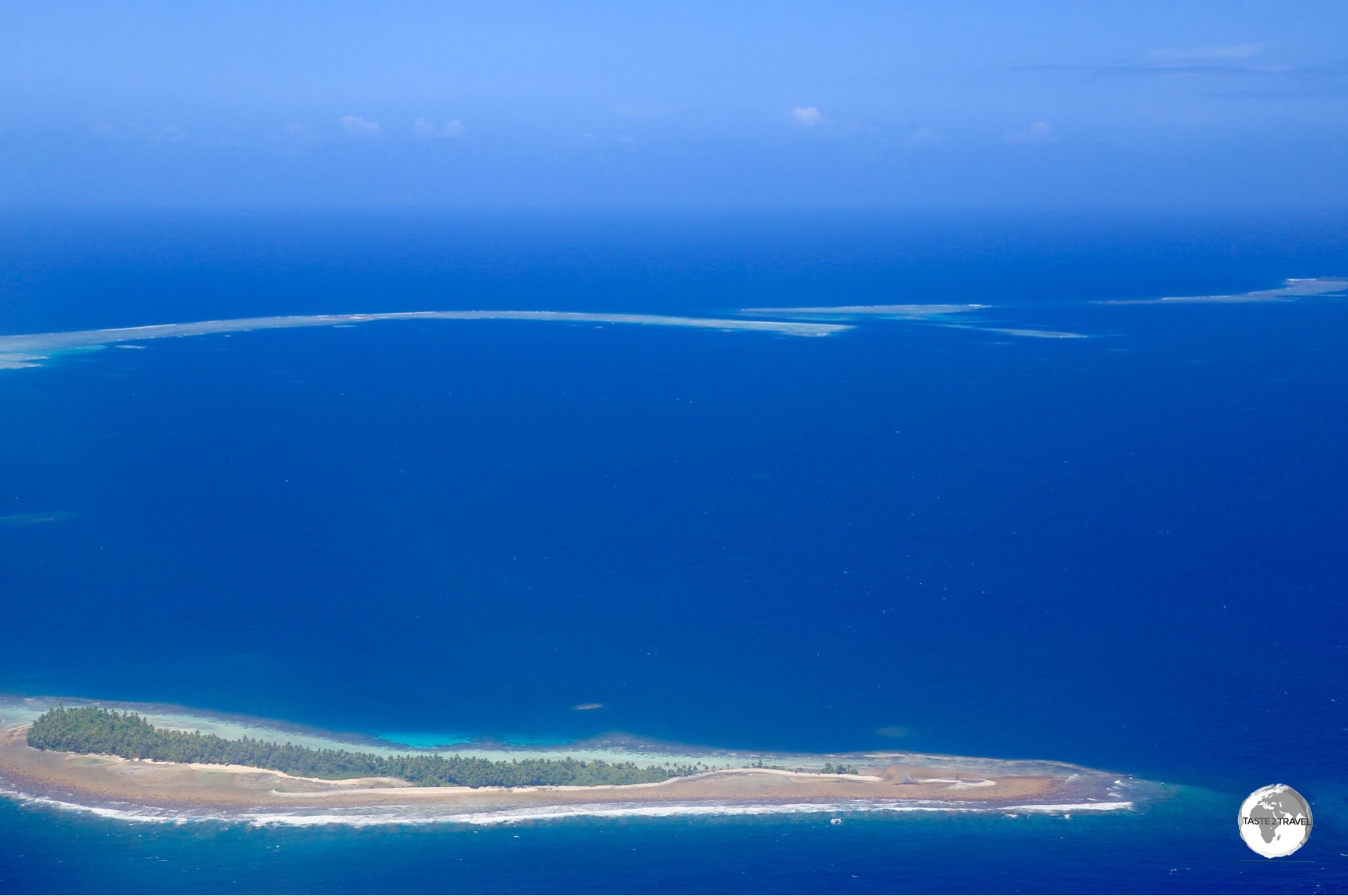
Tuvalu is comprised of narrow slivers of land surrounded by the vast blue expanse of the Pacific ocean.
History

A shipwreck in the lagoon north of Funafuti port.
Polynesian History
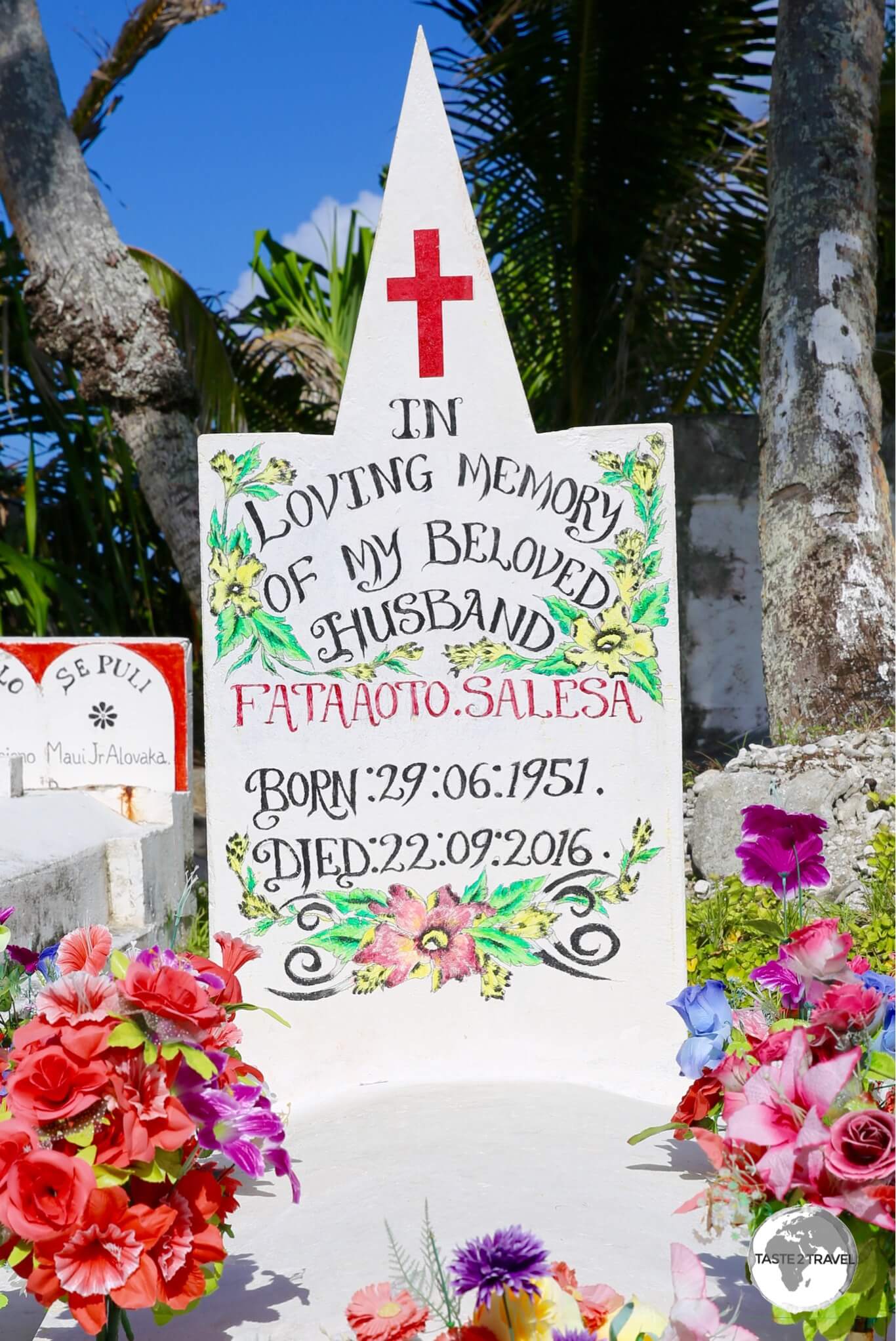
A colourful tombstone on Funafuti.
Tuvalu was first settled in the 14th century by Polynesians who travelled from Samoa and later Tonga, the Cook Islands and Kiribati. All eight islands were eventually settled, giving rise to the name Tuvalu, or “Cluster of Eight”.
European Contact
The Spanish were the first to discover the islands in the 16th century when Álvaro de Mendaña de Neira sighted the island of Nui during a voyage of discovery of the South-west Pacific which originated in Peru. Spain never made a claim on the islands, which remained a backwater until the 19th century when Tuvalu first appeared on European charts.
In 1863, labour recruiters from Peru kidnapped some 400 Tuvaluan’s, putting them to work in gold mines in Peru, reducing the population to just 2,500 people.
In 1892, Tuvalu – then known as the Ellice Islands – became a British protectorate and in 1916, was made part of the Gilbert (present day Kiribati) and Ellice Islands Colony.

A colourfully decorated grave on Funafuti.
During World War II, U.S. forces were based on the islands of Nanumea, Nukufetau, and Funafuti, but hostilities did not reach the islands. The Americans used their base on Funafuti to launch their strike against Japanese forces on Kiribati, in what would become known as the famous ‘Battle of Tarawa’. For more on this battle and to view graphic front-line footage from an embedded camera team, please refer to my Kiribati Travel Guide.

Rusted WWII construction equipment left on Tuvalu by US Marines (‘Seabees’).
Tuvalu Today

The Tuvalu Government building (opposite the airport) houses all government departments.
During the 1960’s, racial tension and rivalries created friction between the Gilbertese and Ellice Islanders. A referendum in 1974 resulted in Tuvalu becoming a separate colony and then, in 1978, fully independent.
While the country today produces very little (GDP is about US$30 million per year) the main challenge for this flat atoll nation is from Global warming and rising sea-levels which threaten to one day wipe the country off the map.
Tuvalu Tourism

A curious White tern on Funafuti, a bird watcher’s paradise.
Tourism in Tuvalu is managed by the Ministry of Foreign Affairs who have their office inside the Government Building.
Any enquiries should be direct to Ms. Tepola Esekia who can be contacted through the official tourism website – Timeless Tuvalu.
A Nation Under Threat

A view of Tuvalu from my Fiji Airways flight. The thin, flat atolls are slowly being inundated due to rising sea levels.
Tuvalu has drawn worldwide attention recently due to climate change since the United Nations included the islands in a list of places that could completely disappear due to rising sea levels in the next century.

The narrowest point on Funafuti, Tengako peninsula, is wide enough for a single-lane road, which is often inundated.
With an average elevation of less than 2 metres (6.6 feet) above sea level, Tuvalu is the 2nd flattest country on Earth (after the Maldives) and as such, is highly vulnerable to rising sea levels caused by Global warming.

While normally calm, during severe storms, the seas inundate Funafuti.
Already king tides and storm surges regularly inundate Tuvalu, which lead to a loss of land and a scarcity of freshwater. The Prime Minister, Enele Sopoaga, has been increasingly vocal about the fact that time is running out for his country.

The Prime Minister of Tuvalu – Enele Sopoaga – talking about the threat of climate change to his country during a function for the visiting Japanese Ambassador.
Along with other atoll countries – Kiribati, Marshall Islands, Tokelau and The Maldives, Tuvalu is a member of the Coalition of Low Lying Atoll Nations on Climate Change (CANCC) whose aim is to focus global attention on the effects of rising sea levels on the member countries.
Flag

The flag of Tuvalu.
Designed by Vione Natano, the flag of Tuvalu is similar to the flag of nearby Fiji in that is features a Union Jack on a light blue field. The Union Jack is symbolic of Tuvalu’s links with Britain and other Commonwealth members.

The flag of Tuvalu flying over Funafuti (seen here in reverse).
On the fly side, nine yellow stars represent the nine islands which comprise this atoll nation. The arrangement of the stars is geographically correct, with the easterly islands lying more to the north.
Currency & Money Matters

The official currency of Tuvalu is the Australian dollar.
The official currency of Tuvalu is the Australian dollar, with both notes and coins in circulation. The current exchange rate for the Australian dollar against the US dollar is: USD$1 = AUD$1.38
To check todays rate, please click here.

The Tuvalu 50 cent and Australian 20 cent coins are obviously different sizes in this enlarged photo but when held in your hand they are very similar.
Additionally, Tuvalu mints its own coins (in Australia), but confusingly the Tuvalu 50 cent coin is very similar to the Australian 20 cent coin and the Tuvalu $1 coin is very similar to the Australian 50 cent coin.

Although they look different when enlarge in this photo – when held in your hand, the Tuvalu $1 coin and Australian 50 cent coin are similar in shape and size.
Located opposite the airport, you’ll find Tuvalu’s one commercial bank – The National Bank of Tuvalu (NBT). The NBT is the sole provider in Tuvalu of banking services involving taking deposits, making loans and engaging in foreign exchange transactions.
There is no monetary authority or central bank in Tuvalu. The NBT performs some monetary functions for the government, including the holding of government accounts and foreign assets.
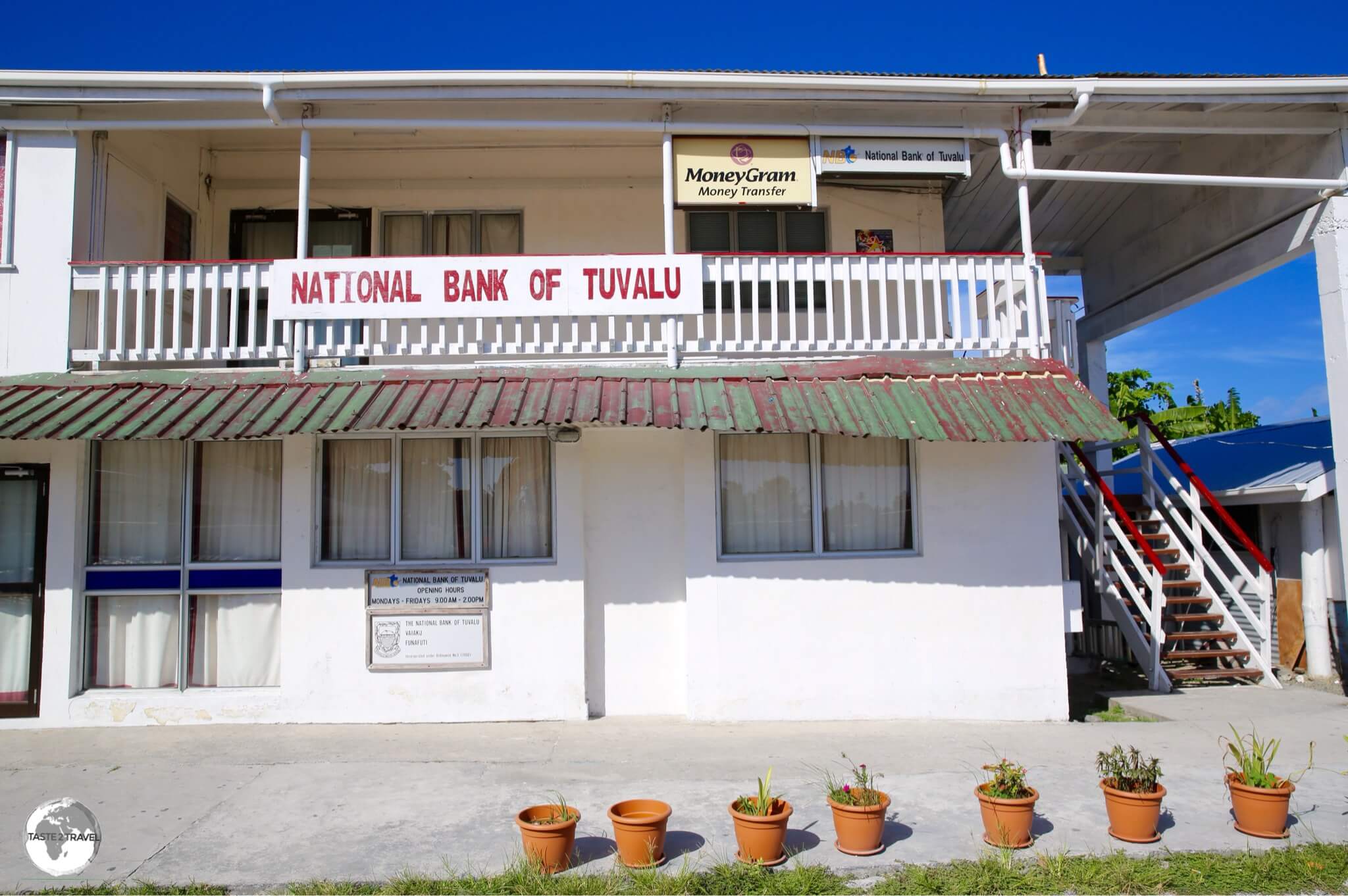
The National Bank of Tuvalu – the only bank on Tuvalu. No credit cards accepted and no ATM available – strictly cash terms.
The NBT is open from 10:00am to 2:00 pm Mondays to Thursday and 9:00 am to 1:00 pm Fridays. It’s important to note that there are no ATM’s in the country and Credit Cards cannot be used anywhere – even at the bank. You need to ensure you bring enough Australian dollars for your entire stay.
There are however a couple of options should you run out of cash:
Option 1: Prior to arriving in Tuvalu, you should ensure you have an online account with either Western Union or MoneyGram. Once in the country, you will find one agent for MoneyGram in the same building as the NBT and one agent for Western Union at Sulani General store. If you require additional funds you can login to your account, transfer funds to yourself (which will be charged to your credit card at home) then take your passport and transaction number to the agent in Tuvalu who will hand over the cash.
Option 2: The Tuvalu Post Office sells Tuvaluan stamps to collectors all over the world through their website. Since credit card transactions cannot be processed in Tuvalu, the PO uses an agent in Australia for completing online transactions. The General Manager of the PO (Ms Sulia Vaelei) has confirmed that a tourist in need of funds can report to her at the Post Office, where she will take their credit card details, forward them to the agent in Australia who will charge their card and once the transaction is approved she will pay-out the corresponding amount in cash.
Philately

Stamps from remote Tuvalu are collected by Philatelists all over the world.
Stamps from tiny, remote Tuvalu are prized by Philatelists around the world. Since most will never make it to Tuvalu, the Post Office sells the bulk of its stamps online. Each year, this country of 11,000 people produces at least twenty stamp issues with each issue having a print run in the millions. All those stamps find their way into albums around the world.

Postcards featuring Tuvalu stamps from the Post Office.
For those who are visiting the island, you can view the Philatelic display at the post office where you can purchase stamps and postcards. The staff, headed by The General Manager (Ms Sulia Vaelei), are very friendly and helpful.
.tv Corporation

A stamp issue by the Tuvalu Post Office commemorating the .TV Corporation.
Back in the late 1990’s when internet domain names were allocated by ICANN, Tuvalu was handed a windfall when it was assigned the .tv country code top-level domain name. The domain name is popular, and thus economically valuable, because it is an abbreviation of the word television.
After Tuvalu was allocated the .tv suffix, the Government worked with the International Telecommunications Union to establish a process to select a management partner for the domain suffix. In 1998, the government of established the .tv Corporation to manage/ oversee the domain name business.
A deal involving an up-front payment of US$50 million for exclusive marketing rights to Tuvalu’s domain (until 2048) was signed with a Canadian company – Information.CA.
After failing to make the agreed payment, a California company – Idealab – became involved and assumed the $50 million obligation to be paid over 10 years. With its first $1 million payment, Tuvalu was finally able to afford to join the United Nations.
In 2001, the .tv Corporation was sold to Verisign. In 2012 VeriSign renewed the contract with the Government of Tuvalu to manage the .TV registry through to 2021.
Internet
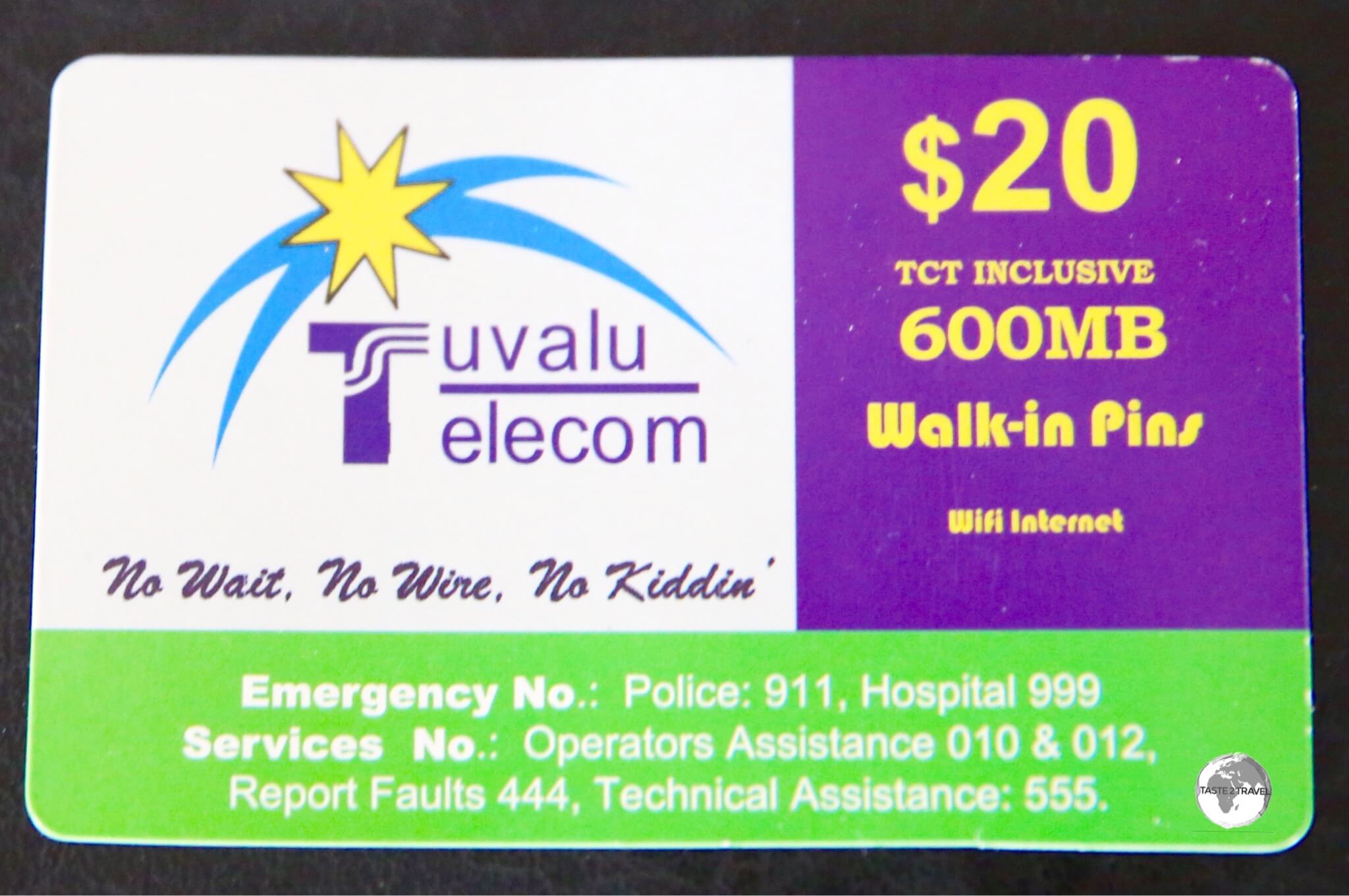
A TCC Wi-Fi card.
Despite selling the rights to the .tv domain name for US$50 million, it’s clear little investment has been made in the sort of IT/ Telephony infrastructure that would deliver decent internet to this remote corner of the Pacific.
Internet reception in Tuvalu is terrible and getting a connection is a true test of patience and perseverance!
To access the internet, you first need to purchase a Wi-Fi card from the Tuvalu Telecommunications Corporation (TCC) which costs $20. This provides you with 600MB of data which is to be used within 14 days.
The problem with all the cards is that the logon name and password are blurred and illegible. The locals seemed to have found a way to decipher the text, so asking someone is the best bet or taking a photo with your phone and enlarging it also helps!

All TCC Wi-Fi cards feature blurry logons and passwords.
Rather than buying a card and trying to decipher the blurred mess, you can purchase your Wi-Fi access directly from the TCC office, where you’ll be handed a printed strip of paper with the login details clearly printed.
The office is on the ground floor of a very non-descript breeze-block building (tucked in behind the green Tuvalu Development Bank building) across the road from the airport. The building has no signage or directory to indicate the tenants but the TCC office is at the end of the hall, past the Fiji Airways office.
Once you have your access details, you can then take part in the national pastime which involves you (and everyone else) trying to get a connection to the outside world. It ain’t easy and some days it’s impossible.
The best place to try to connect is directly under the communication tower located across the road from the airport. Once you have a connection, you can open your desired website and make a cup of tea while it loads. Often, the connection will drop before anything loads. Then you start all over again. Welcome to FUN!
Internet Café

The TPL Internet Cafe offers reasonable internet speed.
If you lose your patience trying to connect to the Wi-Fi, you will find respite, at the TPL Internet Café, which is located inside the Post Office building. Open seven days a week (until 11pm), you enter the café through the door on the airfield side of the building.
Handicrafts

Painted, hand-woven Tuvaluan fans make for nice souvenirs.
Tuvaluan handicrafts include woven products such as fans, mats and baskets, hand-printed linens, woodcarvings and necklaces.
Although there are no souvenir shops in the country, as I travelled around Funafuti, I passed different groups of people producing handicrafts who were happy to sell their products.

Hand-painted linens make for colourful and unique souvenirs of Tuvalu.
Kaica Tapulaa Co-operative
A great place to purchase hand-printed linens is from the Kaica Tapulaa Co-operative.
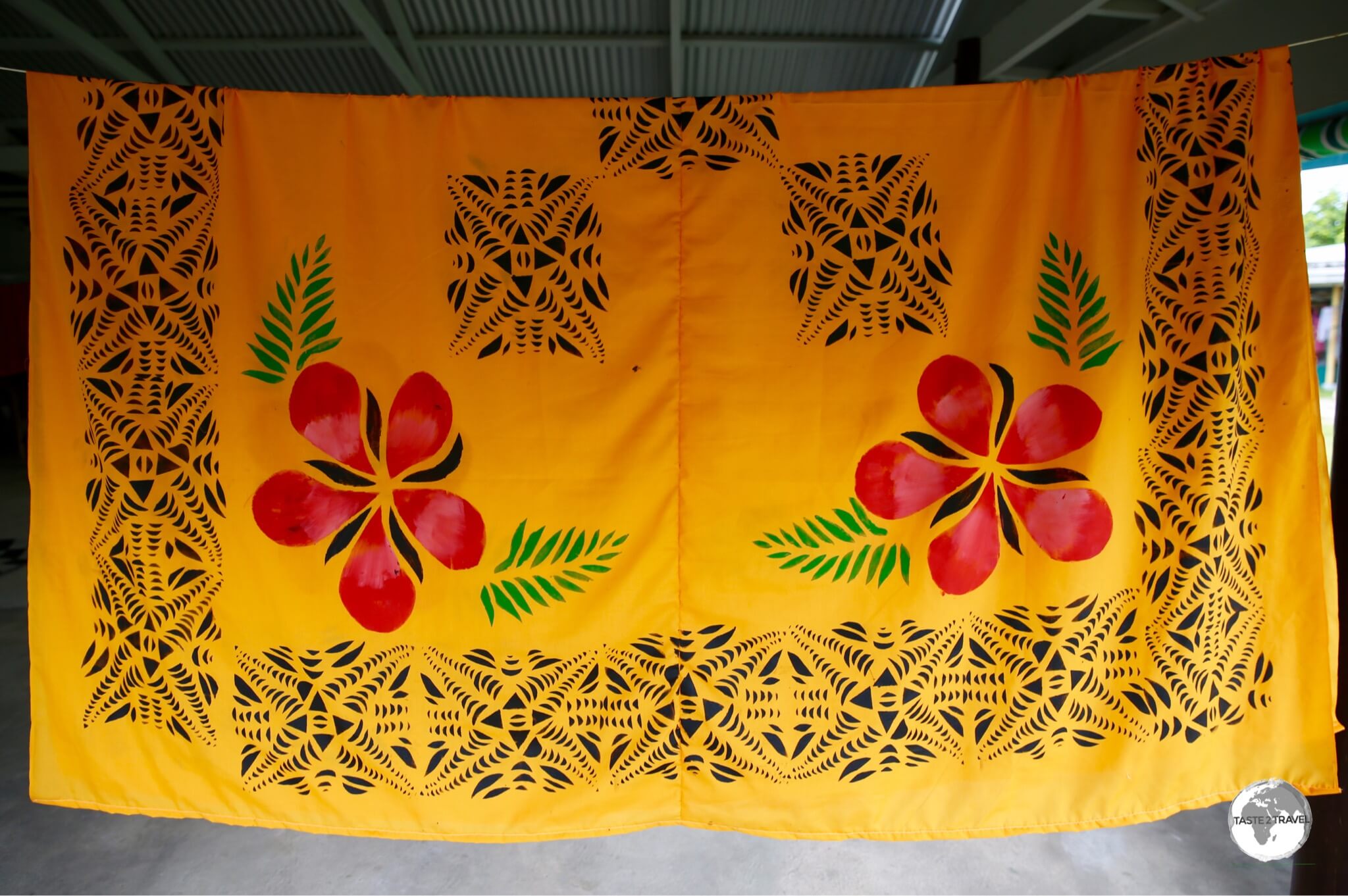
Hand-printed linen at the Kaica Tapulaa co-operative.

Hand-printed pillow cases at the Kaica Tapulaa co-operative.
The artisans at the co-op use cut-out stencils (made from old x-ray film) to hand-print the linen.

A craftsmen hand-painting a bed sheet.

The cut stencil is actually an old x-ray.
Whenever a Fiji Airways flight comes to town, ladies selling handmade shell necklaces setup stands outside the airport terminal, selling their wares to departing Tuvaluan’s who love to wear them on the flight as a reminder of home. At a few dollars each, they make for inexpensive souvenirs.

Necklaces for sale outside the airport terminal on Funafuti.
Sights
Funafuti Lagoon

Palm trees on Funafuti Lagoon.
Funafuti Lagoon is the main star of the show in Tuvalu. The lagoon is 18 km (11 miles) long and 14 km (9 miles) wide with an average depth of about 36.5 metres / 120 feet. With a surface area of 275 square kilometres (106.2 square miles), it is by far the largest lagoon in Tuvalu.
As a comparison, the total land area of Tuvalu is 2.4 square kilometres (0.9 square miles), which is less than one percent of the total area of the atoll.

The rough, exposed ‘ocean’ side (with it’s sudden drop-off) is too dangerous for swimming.
Funafuti atoll, which is home to 6,320 people (60% of Tuvalu’s population) is a narrow strip of land which ranges between 20 and 400 metres (66 and 1,312 feet) in width. The residents on Funafuti generally face the protected lagoon-side of the island have their backs (or their properties) turned to the rougher ‘ocean’ side of the island.

Palm trees on Funafuti Lagoon.
David’s Drill
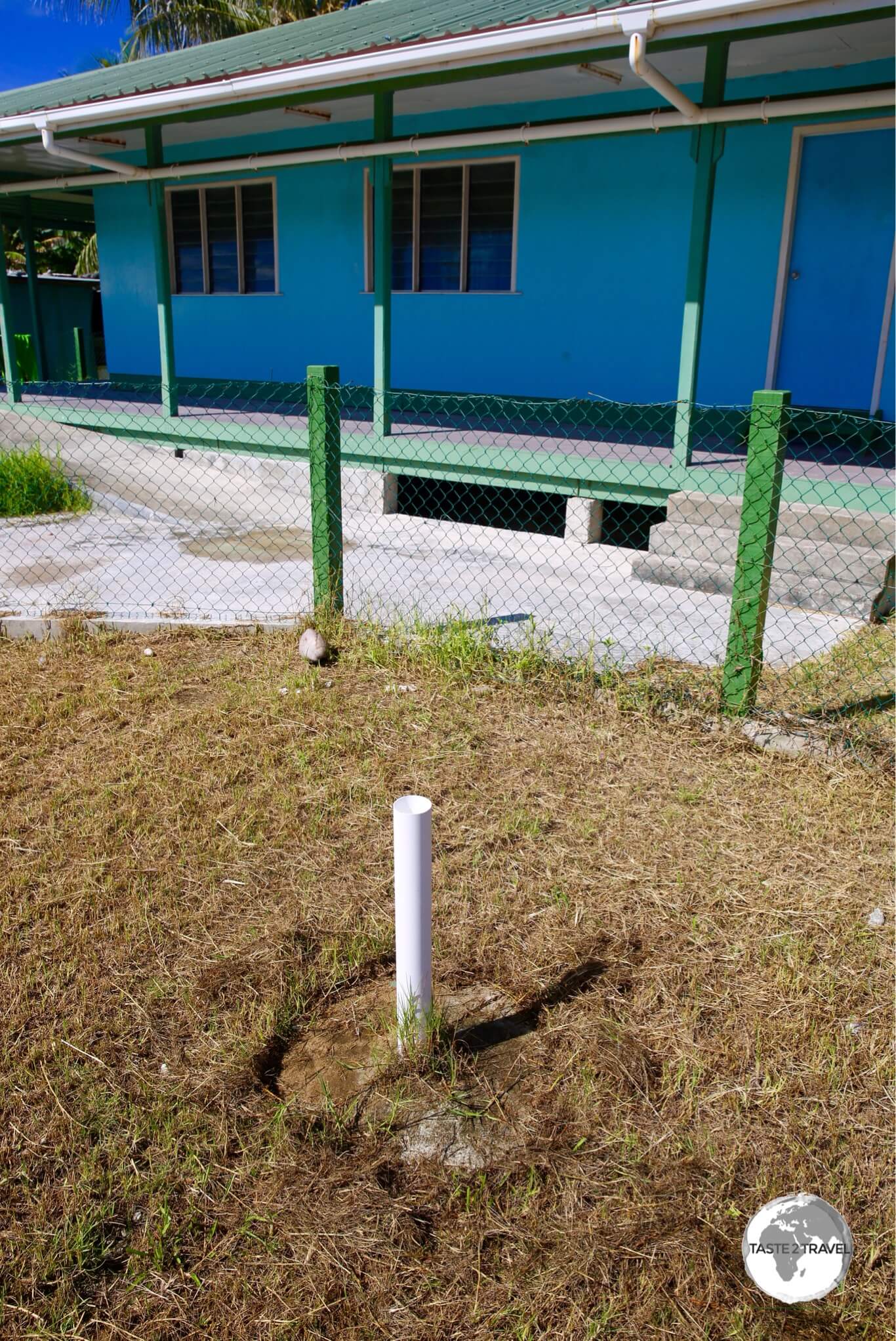
A white PVC pipe marks the bore-hole from David’s Drill.
There are few sights to visit in Tuvalu. One odd spot to seek out is known as David’s Drill. I won’t give away the exact location (that will spoil the fun!) but located in a back street near the eastern end of the runway, you’ll find a very unceremonious white PVC pipe protruding from the grassy footpath. There is no marker or any sign to indicate this is anything special. Like everything on Tuvalu, it’s all wonderfully low-key.
Despite the unpretentious nature of the site – the events that took place here in 1896 made Tuvalu famous and (after they had consulted their Atlases), made people in other countries aware of Tuvalu’s existence.
It was here that researchers from the Royal Society of London, accompanied by Australian professor Edgeworth David (hence the name), drilled down to 340 metres to test Charles Darwin’s theory of coral atoll formation. The results of the drill were inconclusive but a second drill many years later on the Marshall Islands (and to a depth of 1,300 metres) proved Darwin’s theory was correct.
WWII Ruins

The concrete ruins (background) of the former WWII seaplane ramp and the rusted, overturned wreck of the pulling-bulldozer at Tausoa beach.
In their fight against the Japanese during WWII, US marines used Tuvalu as a base and today some war relics remain. On the lagoon side of the island at Tausoa beach (behind the Funafuti Town Hall), a series of broken concrete slabs litter the shoreline.

An archive photo from WWII shows the ramp in operation prior to the completion of the airfield.
Source: Wikipedia
These slabs were once a sea-plane ramp, which was built by the same US marines (‘Seabees’) who built the main runway. In the water beside the slabs is the rusted up-turned remains of the bulldozer that was used to pull the planes up the ramp.
If you travel to the northern end of the island, you’ll pass the rusted remains of another war relic. Built by Northwest Engineering of Chicago, this piece of heavy equipment was one of many used all over the world by US Forces to construct runways.
At the northern end of the island, the tarmac road ends at the gates of the island’s dump site. If you continue on the gravel road through the dump, you’ll end up at the northern tip of the island where the track becomes soft and boggy (challenging on a motorbike).

A US-built WWII installation which once guarded the entrance to the lagoon at the northern end of Funafuti.
If you follow the walking trail to the end of the island, you’ll come to the channel which separates Funafuti from neighbouring Amatuku. In the channel is the concrete foundation remains from a WWII installation, which was possibly used to protect the entrance to the lagoon.
Official Buildings
Back in town, opposite the runway, is Tafola (meaning ‘Welcome’), the unpretentious residence of the Prime Minister, Enele Sopoaga.

“Tafola” is the unpretentious, low-key, official residence of the Prime Minister of Tuvalu.
The PM’s residence must be the only one in the world not surrounded by a security fence and without any security guards. I often saw locals taking short-cut across the lawn, and although there is zero traffic on Funafuti and his residence is located downtown, the PM always travels with an official motorcycle escort – with sirens blazing! Most outings involve a three minute drive!

Tuvalu Government house, the official residence of the Governor General.
Next door to Talofa is Government House, the residence of the Governor-General, which was being repaired at the time of my visit following damage from a storm.
The Governor-General of Tuvalu is the representative of the Tuvaluan monarch (currently Queen Elizabeth II) and performs the duties of the Queen in her absence. The last Governor-General, Sir Lakoba Italeli, left office in August 2019. Since then, an incumbent, Teniku Talesi has been acting Governor-General.
Cemeteries

Some families bury their dead family members in cemeteries while others bury them in their front gardens.
While exploring Funafuti, it’s worth stopping at the few roadside cemeteries to view the colourfully decorated gravestones.
Filipino Jeepney

An abandoned Filipino Jeepney lies on the beach on Funafuti – a long way from the streets of Manila.
In a country where there is a paucity of sights, you have to find joy in the unusual and quirky. Located on the beach, north of the port, lies an abandoned Filipino Jeepney.

Views of Funafuti Lagoon through the windows of an abandoned Filipino Jeepney.
Normally seen buzzing around the streets of busy Manila, this Jeepney is a long way from home.
Why is it here?
According to this article which was published in the Manila Sun on 4th of February 2005, the Jeepney was imported by a Filipino expat, Alan Loristo, a technology specialist who created the only internet cafe on Tuvalu.
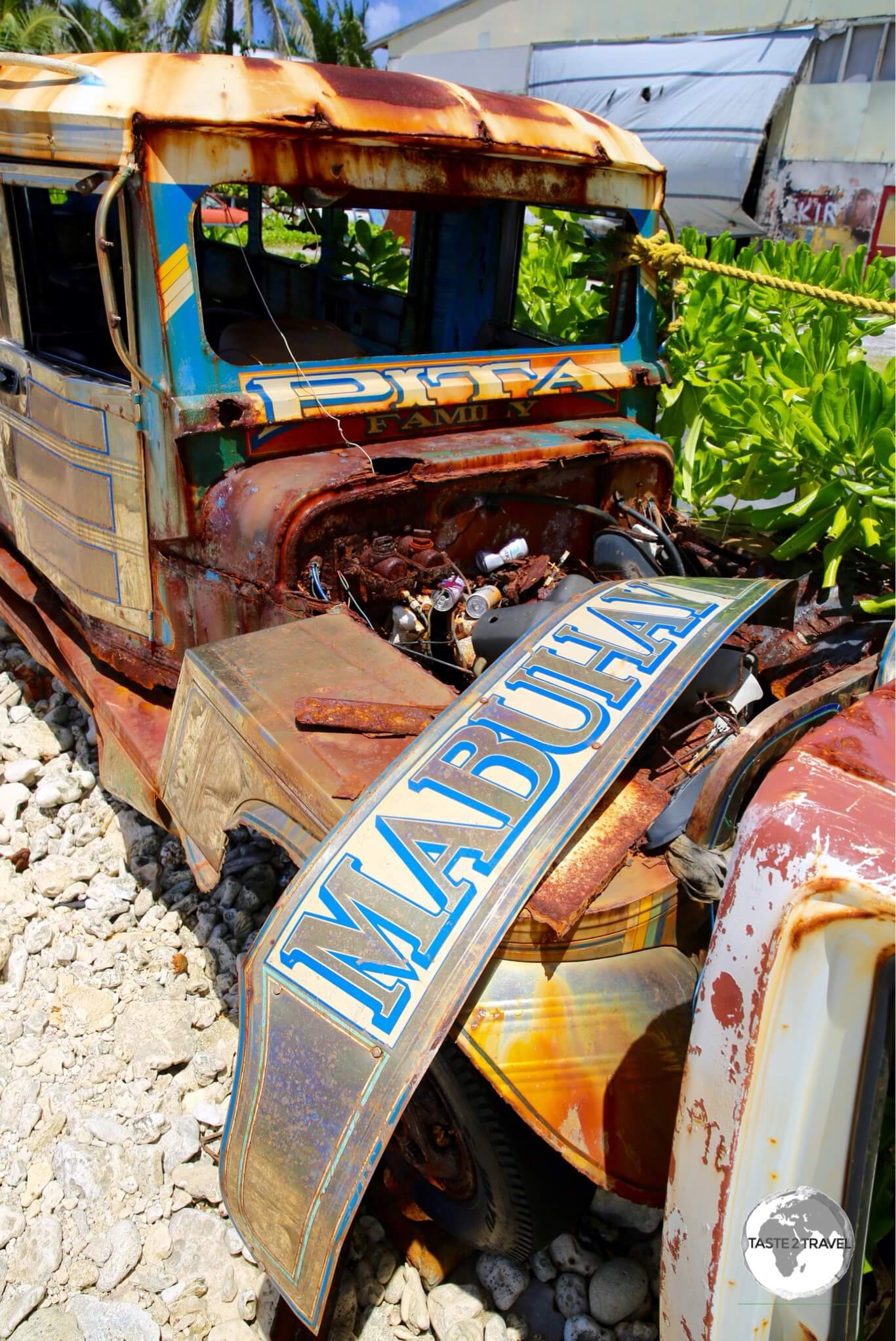
The abandoned Filipino Jeepney still sports its ‘Mabuhay’ (means “Welcome” in Tagalog) panel.
Accommodation
Funafuti Lagoon Hotel

The only hotel on Tuvalu, the (maybe 1.5-star) Funafuti Lagoon hotel.
There is just one hotel in Tuvalu, the Funafuti Lagoon Hotel. (formerly the Vaiaku Lagi Hotel), which is a 2-minute walk from the airport, overlooking the lagoon. The hotel is very old and tired and would be rated 1.5-stars anywhere else, but on Tuvalu it’s #1 and the place where visiting VIP’s are housed. During my stay the US and Japanese Ambassadors (paying a brief visit from their Embassies in Suva) stayed at the hotel.
L’s Lodge

The comfortable living room at L’s Lodge which includes satellite TV.
During my week long stay on Tuvalu, I stayed at the comfortable and welcoming L’s Lodge. Having checked the few other options on Funafuti, this is the one place I would recommend.

Rooms at L’s Lodge are very cosy and homely.
Located in a quiet neighbourhood at the eastern end of the runway, L’s provides reasonably priced rooms with either shared bathroom or ensuite bathroom.
For an extra charge, L’s offer a cooked breakfast (bacon, eggs, toast, plunger coffee) which is the best breakfast on the island and, for Australians missing home comforts, they also provide Vegemite.
Other Accommodation Options
Directly next to the airport is the popular Filamona Lodge which offers rooms in an upstairs house with a lively bar and restaurant downstairs.
Elsewhere in town, you’ll find Esfam Lodge, Militano Lodge, Vailuatai Lodge, Wamasiri Lodge and Talofa serviced apartments.
Ten minutes by boat from Funafuti on Mulitefala Island is Tuvalu’s only resort – the basic, four-room Afelita Island Resort
Eating Out
Cuisine
The cuisine of Tuvalu is based on the staple of coconut and the many species of fish found in the ocean and lagoons of the atolls. Generally speaking, Tuvalu is no culinary hotspot. There are very few restaurants in the country and produce is imported. With an average yearly income of around USD$3,000, Tuvaluan consumers are very price-sensitive, therefore cheaper food items tend to be imported, with unbranded, generic items dominating supermarket shelves.
Fresh local produce includes bountiful seafood (Tuna is king), papaya, plantain, breadfruit and coconut. There are many pigs kept in (very fragrant!) stalls around the island, providing an abundance of pork, which is mainly consumed at celebrations.

English cabbage growing at the Taiwanese farm project alongside the runway.
Growing produce in the limestone soil of a coral atoll is impossible – but – thanks to a Taiwanese aid project (which has seen raised planter boxers installed alongside the runway), some vegetables are now being cultivated on the island. When I visited the project, the planter boxes were full of cabbage and cucumber, which would explain the presence of cabbage in every meal I ate on the island.

A Tuvaluan worker tending the vegetable garden at the Taiwan-sponsored project.
Alcohol
As for alcohol – all beer is imported with popular brands being Fosters, VB, San Miguel, Red Horse and Pure Blond. Some wine and spirits are also available.
Bars can be found at Filamona Lodge and the Funafuti Lagoon Hotel. According to Tuvalu law – alcohol can only be served for lunch and in the evenings from 6:30 pm to 10:00 pm, with bars promptly closing at 10:00 pm.
Coconut Toddy
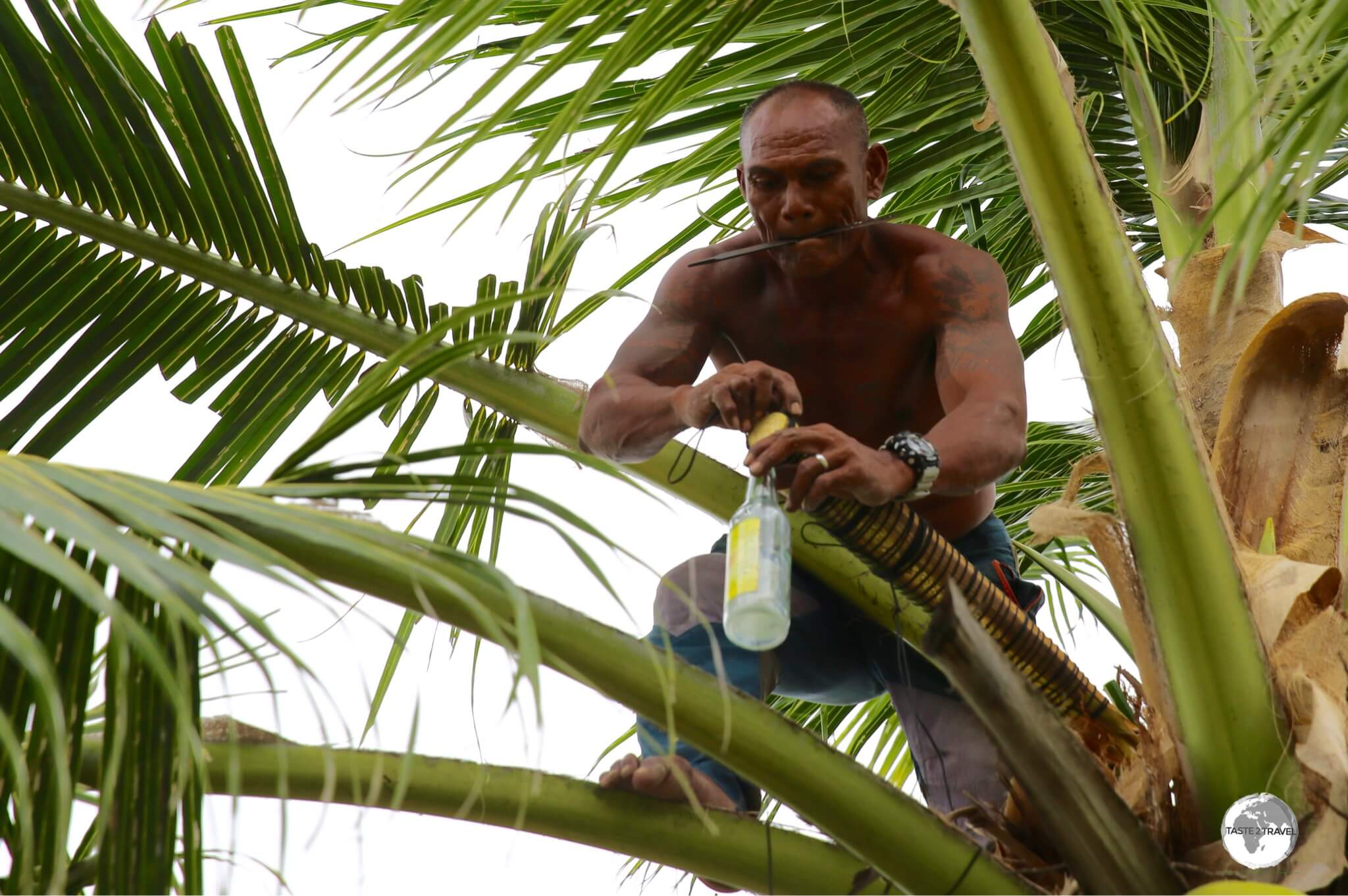
A Tuvaluan ‘tapper’ preparing to collect sap for his next batch of Coconut Toddy.
Not all alcohol however is imported. A local version of Palm wine, ‘Coconut Toddy’, is produced on Funafuti by ‘tappers’ who ferment alcohol from the extracted sap of the coconut palm.

A bottle is used to collect sap from the coconut tree for toddy.
The sap is collected in bottles, which are placed beneath incisions which are made in the palm. You can see ‘tappers’ in action as you travel along the main road. The white liquid is initially sweet and non-alcoholic but once fermented, an aromatic, mildly intoxicating, sweet wine (with up to 4% alcoholic content) is produced.
Coffee
As for coffee – there are no cafe’s in Tuvalu and nowhere did I see a coffee machine. The best coffee I found was at my guest house (L’s Lodge) who offer plunger coffee – very nice!
Restaurants
Of the restaurants, the Funafuti Lagoon Hotel offers breakfast, lunch and dinner. I tried their grilled Tuna steak (served with mashed potatoes and cabbage) for dinner one evening which was one of the tastiest meals I had on Tuvalu. Another evening I ate local roast pork with chips (and a side of cabbage) with was also very good.
If the government has a function, catering will be provided by the hotel (which is government owned).
Across the road from the airport is the Filamona Lodge , the favoured haunt for the tiny ex-pat community. The staff are friendly and, if there are a few expats around, the atmosphere will be livelier than anywhere else in town. Beers are often served on the warm side and the meals are hit and miss. One night I had a delicious roast chicken dish (with a side of cabbage), another time I had something that was totally unremarkable.
There are two low-key Chinese restaurants on Tuvalu. The Blue Ocean Restaurant (on the main street) specialises in preparing poor versions of standard Chinese classic dishes. loaded yup with lots of cabbage.
One hundred metres further along the same road (back towards the airport) is another Chinese restaurant – simply called Fast Food Restaurant which does better tasting food.
One of my favourite places to eat was the tiny Fish ‘n’ Chip takeaway shop (no cabbage here), which is attached to the convenience store opposite the USP (University of South Pacific) campus. You can pay either $3 or $5 for a portion of breaded local tuna and chips and join the locals for lunch under the shade of the tree outside.
Visa Requirements

My Tuvalu passport stamp.
Most nationalities are granted a free 30-day Visitors visa upon arrival, with Schengen-zone passport holders receiving a 90-day stay. You can check your requirements here.
Immigration Requirements

The Tuvalu Arrival Card.
All arriving passengers will be handed a Tuvalu Arrival Card on their Fiji Airways flight. The card consists of four separate declarations which are collected by four different departments upon arrival.
Getting There

The view of Funafuti, on final approach to the airport from my Fiji Airways flight.
For most visitors to Tuvalu, the only sensible means of transport to this remote corner of the world is on one of the thrice-weekly flights with Fiji Airways from Suva, Fiji.

On approach to Funafuti International airport.
On approach to Funafuti airport, the best views of the islands are from the left side (seats A & C) of the plane. Upon departure there are views immediately from the left side, then – after a right-hand turn – the plane passes back over the island, providing panoramic views from the right side of the plane.
The 1,060 km journey between Fiji and Tuvalu takes 2 hours and 35 minutes.
EFiji airways arriving at Funafuti International Airport.There are occasional ships (see ‘Inter-island & International Ferries‘ below) which make the 1,060 km sea journey between Fiji and Tuvalu over a period of many days. These ships tend to carry local students to/ from school on Fiji.
Air

Built in WWII by US Marines, the runway at Funafuti International airport occupies the widest part of the island.
History of Funafuti Airfield
The runway at Funafuti occupies the widest part of the island and 16% of the total land area of the island. It stands on land once occupied by a coconut palm plantation, with 22,000 out of 54,000 trees being destroyed during the construction phase.
Constructed during 1942, by the U. S. Navy 2nd Naval Construction Battalion (aka the “Seabees“), Funafuti airfield was used during WWII for reconnaissance missions against Tarawa, Mili and Jaluit, all of which were occupied by the Japanese.
I briefly cover the ‘Battle of Tarawa‘ in my Kiribati Travel Guide, which includes very graphic footage of a raid conducted by American marines against the Japanese on Tarawa. The footage was shot by a media team who were embedded with the Marines.
The first offensive operation from Tuvalu was launched on April 20, 1943 with twenty-two ‘B-24 Liberators’ taking off from Funafuti on a bombing mission against the Japanese on Nauru. I have also included coverage of the events from WWII on Nauru in my Nauru Travel Guide.
Today, Funafuti International Airport (which has the groovy IATA airport code of ‘FUN’), is the only international gateway to Tuvalu.
Because the airport occupies such a large chunk of land, and is seldom used by aviation traffic, the tarmac area serves as a giant recreation ground most of the time.
When a flight is approaching, a siren sounds, alerting everyone to leave the airport grounds. Security cars also block the main road, which runs parallel to the runway, ensuring no cars are about during landing and take-off.
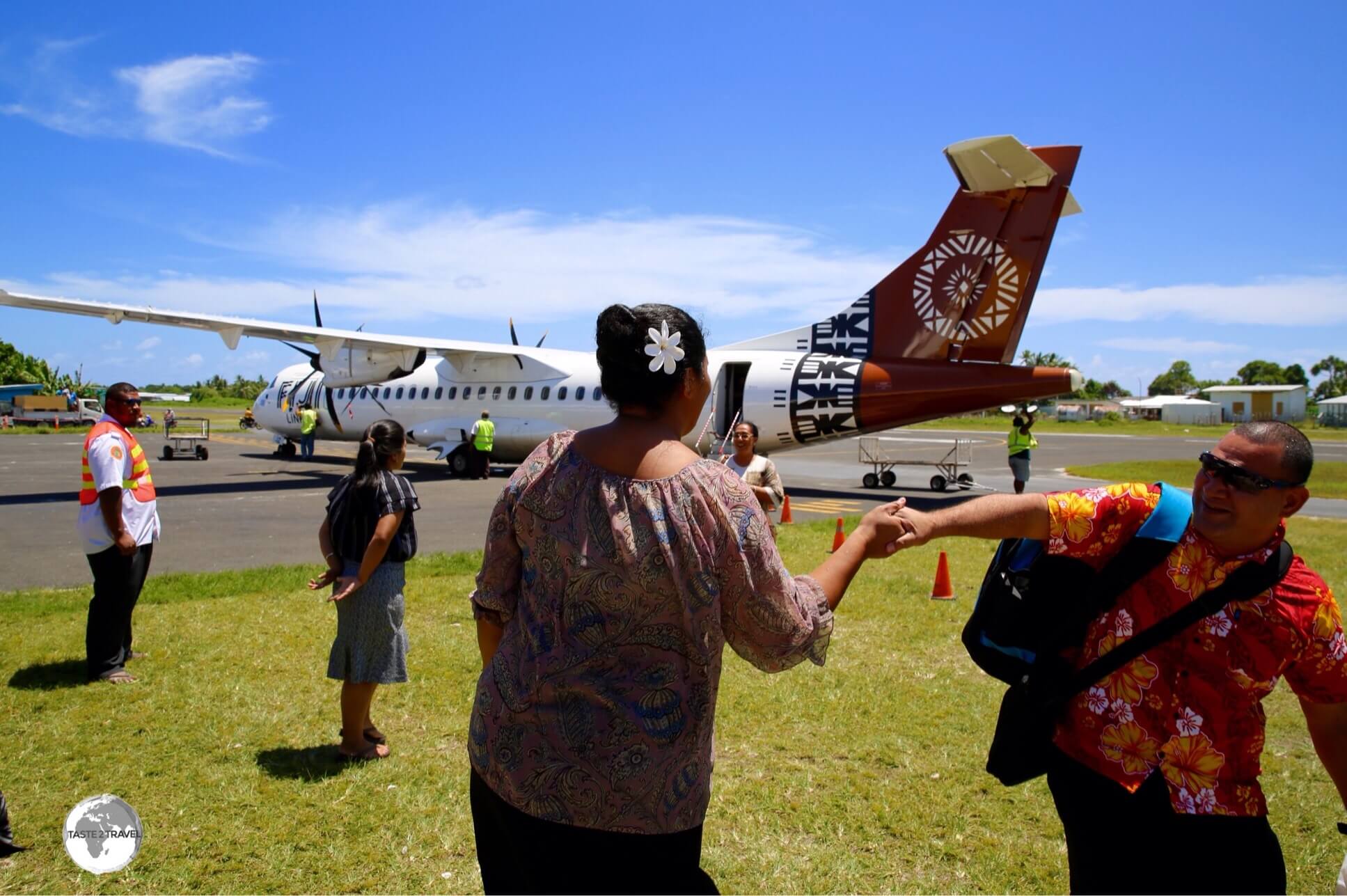
Passengers, almost always returning locals, arriving at Funafuti International airport.
playfround In a country that welcomes just 1,000 tourists per year almost all incoming passengers are returning locals, business travellers or diplomats.
My incoming flight carried the US Ambassador to Tuvalu (who is based in Fiji) and my outgoing flight carried both the Prime Minister of Tuvalu and the Japanese Ambassador (also based in Fiji).

The 3-times weekly Fiji Airways flight is a vital link to the outside world for this remote nation.
The only two airlines providing scheduled services to FUN are Air Kiribati and Fiji Airways.
- Fiji Airways, flies every Tuesday, Thursday & Saturday, departing Suva (FJ281) at 09:00, arriving on Tuvalu at 11:35. The same plane (FJ280) departs Tuvalu at 12:20, arriving in Suva at 14:50. There is no time difference between the two countries.
From Fiji, Fiji Airways offer connections throughout the world.
- Air Kiribati provides a once a week service linking Tarawa to Funafuti. The service departs Tarawa at 12pm on Wednesday and arrives in Funafuti at 3pm it then departs at 4pm and arrives back in Tarawa at 7pm. There is no time difference between the two countries. The service uses Air Kiribati’s Dash 8 100-series aircraft which has the capacity to take up to 35 passengers. Tickets start at AUD$415 one-way.
From Tarawa, Air Kiribati offer connections to Brisbane and Honiara (click to read my Solomon Islands Travel Guide).

Arriving at Funafuti International Airport.
At the time of my arrival, the adjacent, gleaming new, terminal (see below) was one month away from being opened so we were processed in the old terminal which was a rudimentary, open-air, covered shed with a concrete floor. Arrival formalities were relaxed and friendly!

Everything is done manually at the airport.
Once I had collected my baggage, I was greeted by the owner of L’s Lodge who drove me the short distance to my guest house.
During my week on the island, I had the opportunity to partake in the buzz that surrounds the arrival of a flight from the outside world. It’s an event which creates a certain amount of excitement in this otherwise sleepy part of the world. Joining the throng of locals at the airport to see Fiji Airways arriving and depart is a part of the Tuvalu experience.

Tuvaluan’s waving goodbye to departing friends and family at Funafuti International airport (with Filamona lodge in the background).
The arrival of the thrice-weekly flight from Fiji causes quite a buzz on this otherwise sleepy island, with a crowd of locals gathering around the terminal to meet-and-greet returning relatives, say goodbye to departing ones or just watch the commotion.

A final view of Funafuti shortly after departure.
It all starts with the fire brigade truck sounding a siren from the runway when the plane is approaching. This is to warn everyone that a flight is due and to clear locals off the runway, which occupies the widest part of the island and is normally used as a recreation space. There are also several roads/ paths crossing it. The main road running alongside the runway is also closed to traffic during landings and take-off.
New Airport Terminal

The air-side view of the (almost completed) new terminal at Funafuti International airport.
At the time of my visit to Tuvalu, the finishing touches were being applied to a new terminal at Funafuti International Airport (IATA: FUN). The terminal was opened one month later in February of 2018.

‘Welcome’ signage inside the new arrivals hall.
The new facility, which cost $US29.4 million, was part of the Tuvalu Aviation Investment Project, which was funded by the World Bank’s International Development Association. The project provided desperately needed employment for many locals with Australian construction specialists also involved.

A team from Australia install the flooring in the new terminal at Funafuti International airport.
I had the opportunity to step into the construction zone and photograph the new terminal which was almost complete. A team of friendly Australian specialists were busy laying the rubber flooring inside the terminal.
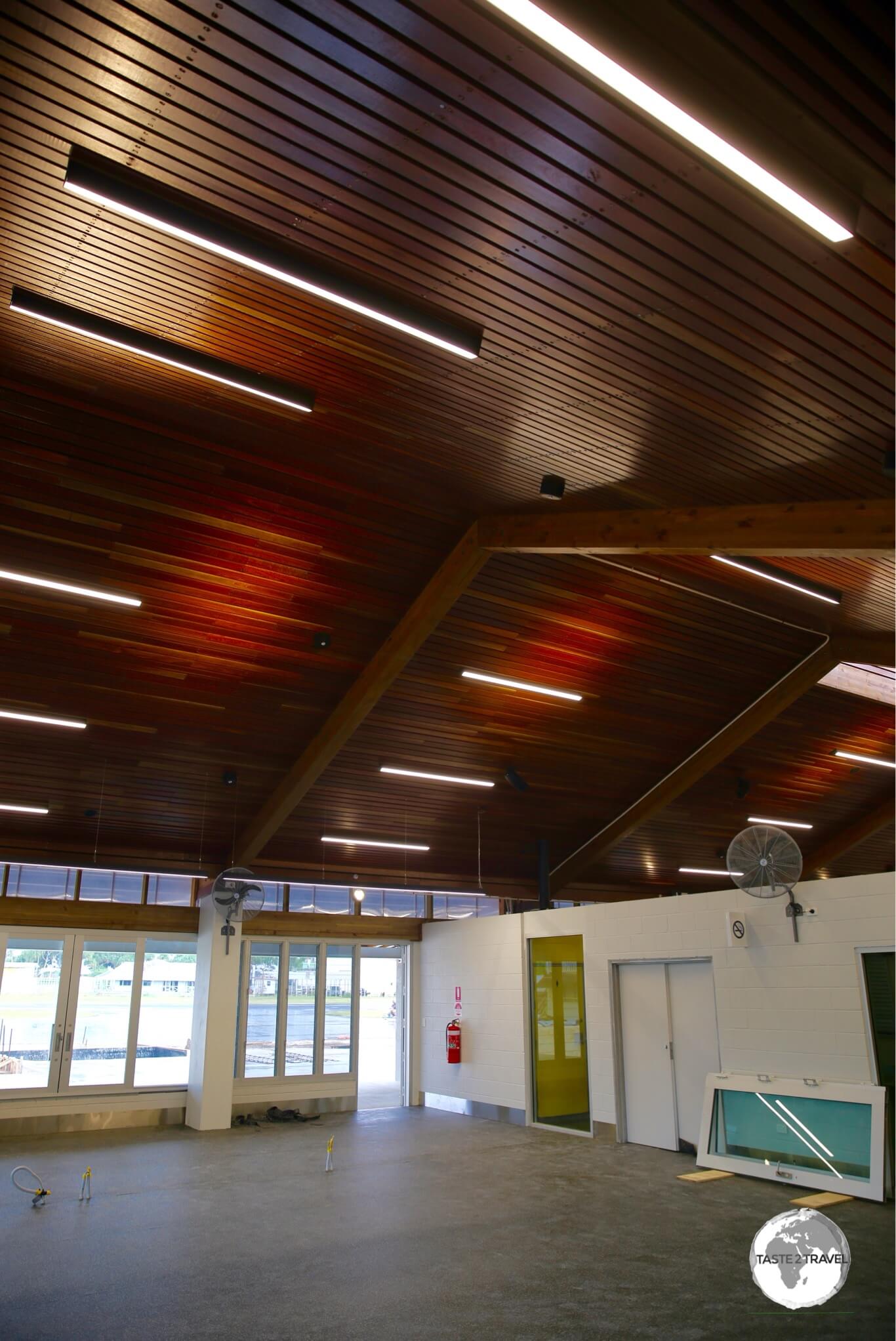
An interior view of the almost-complete terminal at Funafuti International airport.
The logistics of such a large construction project in a remote location are challenging, with all materials being imported as nothing is produced on Tuvalu. There are no hardware stores on the island where you can simply pop out and buy tools and materials. Everything had to be shipped in, with shipping times to the atoll being lengthy.
In the end, what had been created was a shiny new terminal which was, by far, the fanciest building anywhere on Tuvalu – a modern, impressive gateway to this island nation.
Fiji Airways Office
Fiji Airways take full advantage of the fact that they operate in a monopoly environment, charging very high prices for flights to/from Tuvalu. Most locals cannot afford the extortionate airfare, with many forced to travel on the monthly government boat to Suva (a 1,000-km, slow sea voyage).
Across the road from the airport, you’ll (hopefully) find the well-hidden office of Fiji Airways, which is on the ground floor of a very non-descript breeze-block building (tucked in behind the green Tuvalu Development Bank building). The building has no signage or directory to indicate the tenants but the Fiji Airways office is behind a door which is simply labelled ‘Travel’. You can contact the office via email at: traveltuvalu@gmail.com or telephone (+688 20 737)
Next door is the office of TCC and it’s here where you can purchase Wi-Fi access.
Cruise Ship
Two cruise ships visited Tuvalu in 2017, docking at the container dock.
Getting Around
Air
There are no domestic air services in Tuvalu.
Taxi
There is one taxi on Tuvalu which can be booked in advance through any hotel or guest house.
Bus
There are no buses in Tuvalu.
Car Rental

There is one main road on Funafuti which traverses the length of the island.
Rental cars are available at $40 per day from L’s Lodge.
Motorbike Rental

My rental motorbike (a real clunker) at the far northern end of Funafuti.
A Motorbike is the best way to navigate the one narrow road which follows the lagoon side of Funafuti from end-to-end. Bikes are available to rent through guest houses and some shops and cost from $10 – $15 per day. Fuel is sold in one litre units ($1.80/L) from numerous little shops along the main road.

My motorbike on the runway at Funafuti.
Video:
What’s it like to ride your motorbike down a commercial runway?
You shouldn’t try this at home!
I did it because I wasn’t at home!
Inter-island & International Ferries

The notice board inside the lobby of the Government building indicating the next departures of the Inter-island ferries.
The government operates two Inter-Island ferries – the MV Nivaga III and the MV Manu Folau, with the former also connecting Tuvalu to Fiji (Suva).
Tuvaluan students studying in Fiji travel there by boat, rather than paying for the expensive flight. Shipping schedules can be obtained from the ‘Shipping Clerks’ office which is on the ground floor of the Government building. A noticeboard outside the office indicates the next scheduled sailings.
That’s the end of my Tuvalu Travel Guide.
Safe Travels!
Darren
Follow me on Instagram:
Further Reading
Other travel reports from the Pacific region:
Tuvalu Travel Guide Tuvalu Travel Guide Tuvalu Travel Guide Tuvalu Travel Guide Tuvalu Travel Guide Tuvalu Travel Guide Tuvalu Travel Guide Tuvalu Travel Guide Tuvalu Travel Guide Tuvalu Travel Guide Tuvalu Travel Guide Tuvalu Travel Guide Tuvalu Travel Guide Tuvalu Travel Guide Tuvalu Travel Guide Tuvalu Travel Guide Tuvalu Travel Guide Tuvalu Travel Guide Tuvalu Travel Guide Tuvalu Travel Guide Tuvalu Travel Guide Tuvalu Travel Guide Tuvalu Travel Guide Tuvalu Travel Guide Tuvalu Travel Guide Tuvalu Travel Guide Tuvalu Travel Guide Tuvalu Travel Guide Tuvalu Travel Guide Tuvalu Travel Guide
Author: Darren McLean
Darren McLean is an Australian, full-time, digital nomad who has spent 37 years on a slow meander around the globe, visiting all seven continents, 189/ 193 UN countries and 240/ 251 UN+ countries and territories.
He founded taste2travel to pique one’s curiosity and inspire wanderlust.





